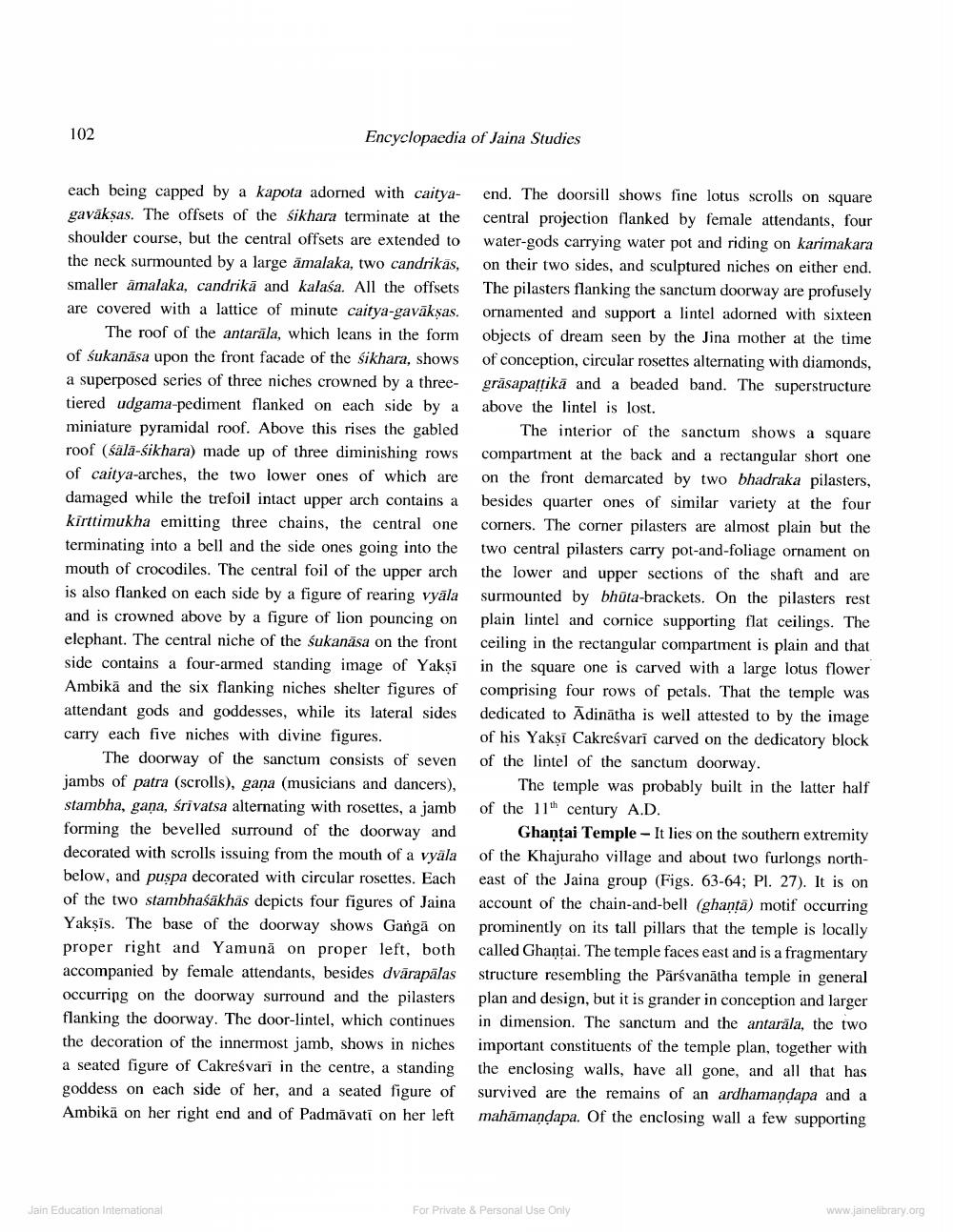________________
102
Encyclopaedia of Jaina Studies
each being capped by a kapota adorned with caitya- gaväksas. The offsets of the sikhara terminate at the shoulder course, but the central offsets are extended to the neck surmounted by a large amalaka, two candrikas, smaller amalaka, candrika and kalasa. All the offsets are covered with a lattice of minute caitya-gavākşas.
The roof of the antarāla, which leans in the form of śukanāsa upon the front facade of the sikhara, shows a superposed series of three niches crowned by a three- tiered udgama-pediment flanked on each side by a miniature pyramidal roof. Above this rises the gabled roof (Salā-śikhara) made up of three diminishing rows of caitya-arches, the two lower ones of which are damaged while the trefoil intact upper arch contains a kirttimukha emitting three chains, the central one terminating into a bell and the side ones going into the mouth of crocodiles. The central foil of the upper arch is also flanked on each side by a figure of rearing vyāla and is crowned above by a figure of lion pouncing on elephant. The central niche of the sukanāsa on the front side contains a four-armed standing image of Yakşi Ambikā and the six flanking niches shelter figures of attendant gods and goddesses, while its lateral sides carry each five niches with divine figures.
The doorway of the sanctum consists of seven jambs of patra (scrolls), gana (musicians and dancers) stambha, gana, śrivatsa alternating with rosettes, a jamb forming the bevelled surround of the doorway and decorated with scrolls issuing from the mouth of a vyäla below, and puspa decorated with circular rosettes. Each of the two stambhasakhas depicts four figures of Jaina Yakşīs. The base of the doorway shows Gangā on proper right and Yamunā on proper left, both accompanied by female attendants, besides dvārapālas occurring on the doorway surround and the pilasters flanking the doorway. The door-lintel, which continues the decoration of the innermost jamb, shows in niches a seated figure of Cakreśvarī in the centre, a standing goddess on each side of her, and a seated figure of Ambikä on her right end and of Padmāvati on her left
end. The doorsill shows fine lotus scrolls on square central projection flanked by female attendants, four water-gods carrying water pot and riding on karimakara on their two sides, and sculptured niches on either end. The pilasters flanking the sanctum doorway are profusely ornamented and support a lintel adorned with sixteen objects of dream seen by the Jina mother at the time of conception, circular rosettes alternating with diamonds, grāsapattik, and a beaded band. The superstructure above the lintel is lost.
The interior of the sanctum shows a square compartment at the back and a rectangular short one on the front demarcated by two bhadraka pilasters, besides quarter ones of similar variety at the four corners. The corner pilasters are almost plain but the two central pilasters carry pot-and-foliage ornament on the lower and upper sections of the shaft and are surmounted by bhūta-brackets. On the pilasters rest plain lintel and cornice supporting flat ceilings. The ceiling in the rectangular compartment is plain and that in the square one is carved with a large lotus flower comprising four rows of petals. That the temple was dedicated to Adinātha is well attested to by the image of his Yakşi Cakreśvarī carved on the dedicatory block of the lintel of the sanctum doorway.
The temple was probably built in the latter half of the 11th century A.D.
Ghantai Temple - It lies on the southern extremity of the Khajuraho village and about two furlongs northeast of the Jaina group (Figs. 63-64; Pl. 27). It is on account of the chain-and-bell (ghanta) motif occurring prominently on its tall pillars that the temple is locally called Ghantai. The temple faces east and is a fragmentary structure resembling the Pārsvanātha temple in general plan and design, but it is grander in conception and larger in dimension. The sanctum and the antarala, the two important constituents of the temple plan, together with the enclosing walls, have all gone, and all that has survived are the remains of an ardhamandapa and a mahämandapa. Of the enclosing wall a few supporting
Jain Education Intemational
For Private & Personal Use Only
www.jainelibrary.org




